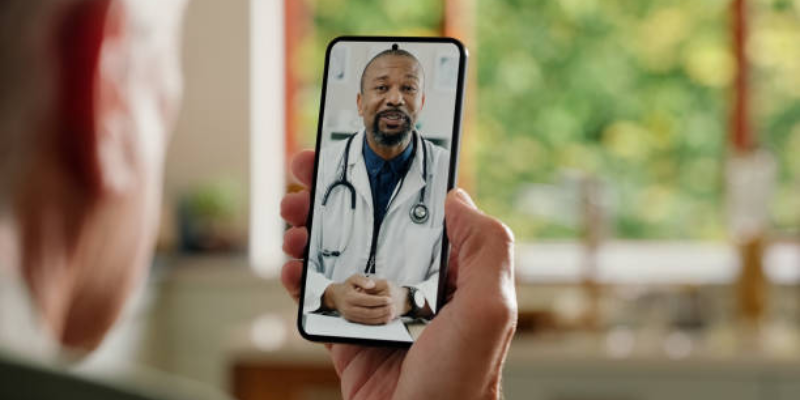Health & medical treatment
How Telehealth Services Improve Access to Care
Telehealth has changed the healthcare industry by connecting patients to their medical practitioners in a new way. Telehealth services use technology to provide an easy and efficient alternative for in person visits. In this piece, we analyze how telehealth services enhance care access, contrast it with other available alternatives, and discuss the impact of telehealth on the future of medicine.
Telehealth has changed the healthcare industry by connecting patients to their medical practitioners in a new way. Telehealth services use technology to provide an easy and efficient alternative for in person visits. In this piece, we analyze how telehealth services enhance care access, contrast it with other available alternatives, and discuss the impact of telehealth on the future of medicine.
A New Style of Method In Caring For Patients
Telehealth Reaches Beyond Traditional Means. Telehealth entails the provision of healthcare services at a distance with the help of technologies like video conferencing, mobile devices, and remote monitoring tools. This approach not only allows patients to consult their medical practitioners but also assists in reaching out to those living in rural and neglected regions. Imagine not having to drive for several hours, or wait weeks just to get a consultation; that can now be done with telehealth as the care is brought to your doorstep.

Fundamentally, telehealth includes the following:
Virtual consultations with healthcare providers through video calls.
Continuous tracking of basic health stats through remote monitoring.
Health apps that help patients remember to take their medication or note any symptoms.
sending medical records like images or test results for later examination by an expert in a secure way known as store and forward services.
Primary Advantages of Telehealth Services
With telehealth, the improvement in healthcare's reach is substantial. Some of the advantages that stand out include:
Ease of Use and Accessibility
No Travel Cost: Patients don’t have to spend time or money traveling, as they can receive care right in their homes.
Make Appointments Anytime: Patients who have a busy schedule can have a video appointment outside of normal office hours.
Better Service for Neglected Groups
Rural Communities: People who live far away from urban centers or in regions with limited healthcare resources can now see specialists without having to travel great distances.
Patients who Cannot Move: Patients suffering from physical illness or long-term conditions can consult clinicians easily without having to visit in person.
Smooth Transitions Between Providers
Many Check-Ups: More regular virtual consultations and check-ins for chronic diseases can significantly improve disease management and reduce complications.
Quick Response to Issues: Telehealth allows for the prevention of major healthcare problems by offering the ability to detect problems and give advice in real-time.
Challenging But High Quality Care
Less Overhead: Without so many in-person consultations, a practice can reduce its overhead expenses which can help patients reduce out-of-pocket costs.
Infrequent ER Visits: Researchers have found that remote care and timely remote checkups do reduce the utilization of emergency departments.
Improved Coordination of Health Services
Provider Collaboration: Telehealth solutions enable collaboration between various providers since they can easily connect to EHR systems that multiple providers use.
Patient Engagement: Patients are now able to engage more actively with health systems because of their access to health information and digital tools.
Telehealth Compared to Other Forms of Health Care: Differences and Consequences
When evaluating telehealth alongside other direct patient interaction services, a number of distinct features arise that highlight the modern advantages of these services.
Ease of Use and Accessibility
Other Forms of Health Care: Workplaces do charge premiums for doing so, and are located close to the patient's residence. This results in long rides and periods when patients have to be in busy waiting rooms.
Telehealth Services: Patients do not have to worry about distance and can receive swift health care with just a click, which is highly advantageous for rural patients as well as people with limited range of motion.
Financial Considerations
Other Forms of Health Care: Most frequently ruins to lose more productivity than is permitted due to the expenses associated with commuting, facilities, and rest stations.
Telehealth Services: Get rid of a large number of these negative impacts. For instance, one particular example indicates that patients may spare a lot of money intended for transportation, not paying for parking lots and, importantly, traffic jams in waiting rooms.
Consistency and Standards of Health Attention
Personal Care: Although tailor-made and personal, face-to-face consultations may, at times, result in a restriction in follow up visits due to changes in availability.
Remote Consultation: Allows for more frequent follow-up and faster changes in treatment plans as is very important in many chronic diseases. Some aspects of care do not substitute in person examination, but rather enhance the care by keeping patients active participants in their health between visits.

Engagement of Technology in Patient Care
Personal Care: More interactions are done in a person’s presence which at times seems impersonal and hurried because of time constraints.
Remote Consultation: Telehealth makes use of technology in patient care making it interesting and lively. These digital platforms have functions like reminders for appointments, access to results, and patient education materials which can increase adherence and satisfaction.
Impacts on Equality on Health Care Access
Remote consulting can address some of the healthcare inequalities by targeting areas that have been historically neglected because patients are location bound, economically disadvantaged, or have mobility problems. It, however, exposes a gap in technology use: not all people have access to fast internet or smart gadgets which means that ensuring equal opportunity to telehealth remains one of the most troubling issues for everyone.
Policy and Technological Drivers Enhancing Telehealth
The growth of telehealth services has been accelerated by both shifts in policy as well as new technology. Here are some factors that have contributed to its rise:
Investment and Market Growth: The rapid increase of telehealth utilization has brought in considerable venture capital investment, which promotes innovation. With estimates that the global telehealth market will expand considerably in the next few years, further investment is likely to result in even greater improvements in access and quality of care.
Technological Innovation: The improvements in internet services, mobile phones, and video conferencing tools have made telehealth easier to use and more effective. At the same time, devices are now available that provide continuous real-time monitoring of vital signs, and secure video conferencing further enhances patient privacy.
Healthcare System Integration: Newer telehealth systems are designed to interface with other healthcare services and allow for electronic health records (EHR)s to be shared. This greatly improves the coordination of care among various service providers.
Regulatory Flexibility: During the COVID-19 pandemic, many governments eased regulations for the duration of the public health emergency in order to increase telehealth coverage. For example, many waivers enabled healthcare professionals to prescribe controlled medications through telehealth which greatly expanded its use.
Getting Started with Telehealth
The adoption of telehealth may be effortless with the right strategy. The following steps will aid both patients and providers in getting started:
Check Your Internet Connection: Stable, high-speed internet is essential for effective virtual consultations. It you have a budget, consider changing your internet plan.
Choose the Right Platform: Telehealth services must have a friendly user interface that allows for easy communication and integrates with existing health records.
Consult with Your Provider: Check with your physician and ask whether they provide telehealth services and how the virtual visits will fit into your overall care plan.
Prepare for Your Appointment: Have your medical history, medications, and questions ready beforehand as you would for an in-person visit. Ensure that you’re in a quiet and private space for your consultation.
Explore Additional Resources: Most telehealth platforms provide educational and support materials. Take advantage of these resources to better understand your condition and manage your health.

Adapting to Telehealth
The benefits of telehealth have shown that there are challenges in digital literacy and even when there is inequitable access to technology, the integrated approach of coordinated care and reduction of travel has bound to solve long standing issues for healthcare systems. Conventionally, health systems have walked on a tightrope between costs and traveling long distances, but with continuous evolvement of technology, this tightrope can be replaced with a sturdy bridge.
Adapting telehealth in health systems also gives patients the ability to experience more personalization along with providers having the ability to expand their targeted demographics. Telehealth is bound to provide aid in changing how locational or circumstantial obstacles are overcome in the growing paradigm of healthcare.
How do you like this article?





 Latest Posts
Latest Posts





